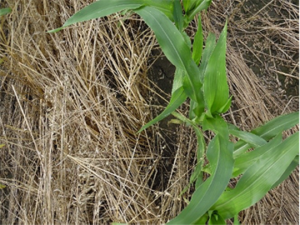
By Barb Baylor Anderson
Protecting topsoil is critical to the future of farming nationwide. In Missouri, cover crops have been found to protect the soil after soybeans but often hurt the next corn crop’s yield. With funds from the Missouri Soybean Merchandising Council, researchers in the state are evaluating a variety of ideas to protect soil after soybeans when most soil erosion occurs.
“Improving opportunities for the soy value chain is central to the mission of the Missouri Soybean Merchandising Council and soy checkoff,” says Kyle Durham, chairman of the council and sixth generation farmer raising soybeans and corn in Missouri’s Carroll County. “On the farm, that translates into solving problems farmers face. This project directly addresses a yield challenge found with incorporating cover crops into Missouri’s most common crop rotation.”
“We used a farmer board to brainstorm ways to protect soil after soybeans without hurting the following corn crop, with the expectation that cover crops would be a key component,” says Peter Scharf, University of Missouri Extension agronomist and principle investigator. “We are testing dozens of their ideas in small plots on the University of Missouri research farm and now we will feed the best ideas to the Missouri Strip Trial Program for on-farm testing.”
Scharf is evaluating yield data from 2020 plots, noting they will document how well all of the ideas are protecting soil on a range of dates following soybean harvest.
“We will take the best performers to the farm,” he says. “We are opening the door to a range of cover crop species and management approaches to see how the cover crop and the following corn crop fare. We will then evaluate the soil protection levels.”
Rye is one crop Scharf says does a great job protecting soil when planted after soybeans, but subsequent corn yields have underperformed. Seven researchers have conducted 57 experiments in Missouri, with an average yield penalty of 12 bushels for the rye cover crop.
“That’s using the least-harmful rye treatment from each experiment,” he says. “One promising idea we’re looking at from our farmer board is putting down 100 pounds of nitrogen with the planter after killing rye at an eight-inch height. We just finished analyzing yields and that treatment yielded almost as much as plots with no cover while providing better soil protection.”
Scharf says another system that performed very well in the first year of trials was winter oats, which were not sprayed until just after corn was planted. He says the system provided the best soil protection among all the treatments that didn’t hurt yield. And if that result holds up over additional years, Scharf thinks think it could work out well for farmers.
“My favorite idea so far from a northwest Missouri farmer at a soil health field day is to let rye get really tall, plant soybeans into it green, then kill it and let that rye residue protect the soil all the way until corn canopies more than a year later,” he says. “It looked pretty good in terms of soil cover in January 2020, even though fall 2018 was terrible for cover crop establishment and growth. It had no effect on corn yield and is relatively easy and cheap for farmers to implement.”
Scharf says on-farm trials of various ideas will be put into place during the fall of 2020.
The post Finding Best Pathways to Protect Soil After Soybeans appeared first on Soybean Research & Information Network.